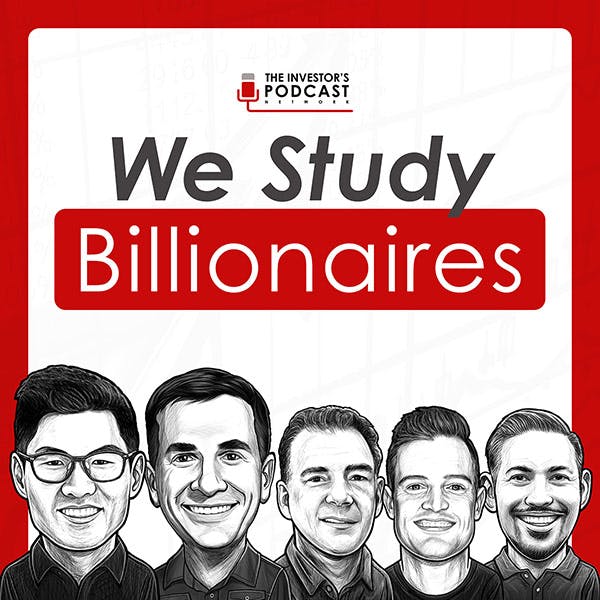
January 24, 2025 • 1hr 19min
TIP693: The Power Law: Unlocking Venture Capital's Secrets w/ Clay Finck
We Study Billionaires - The Investor’s Podcast Network

Key Takeaways
- The Power Law explains why a small number of companies generate the majority of returns in venture capital
- Successful venture capitalists must actively seek out bold, unconventional founders and be willing to back seemingly improbable ideas
- Early VC pioneers like Sequoia Capital and Kleiner Partners helped establish the modern venture capital model of providing both capital and operational support
- The best VCs understand that most investments will fail but the few big winners more than make up for the losses
- Companies are staying private longer which has shifted bargaining power from VCs to founders
- Both luck and skill play critical roles in venture capital success, though the exact contribution of each is unquantifiable
Introduction
In this episode, Clay Finck explores Sebastian Mallaby's book "The Power Law: Venture Capital and the Making of a New Future." The book examines how venture capital has shaped the modern technology industry and why understanding the power law distribution of returns is crucial for success in venture investing.
The power law states that a small number of outlier successes will generate the vast majority of returns. This fundamental principle has guided top venture capitalists in backing bold, unconventional founders like Steve Jobs and Elon Musk who went on to build transformative companies.
Topics Discussed
The Origins of Modern Venture Capital (1:53)
The modern venture capital industry emerged in the late 1940s, with the Rockefeller family being early pioneers who wanted to provide capital to ambitious projects that could benefit society. The industry evolved significantly in the 1950s with two key developments:
- Adoption of equity-only time-limited funds instead of other investment formats
- Development of new risk management approaches suited for concentrated technology investments
- Early success stories like Ampex showed the potential for massive returns
The Davis Rock Partnership Model (19:55)
Arthur Rock and Tommy Davis launched an influential limited partnership in 1961 that established several key elements of modern VC:
- Raised $3.2 million with a seven-year fund life
- 20% carried interest compensation structure for general partners
- Focus on backing talented founders rather than just analyzing financials
- "The single most important factor in the long run for any company is of course management" - Arthur Rock
Sequoia Capital's Rise (27:19)
Founded by Don Valentine, Sequoia Capital pioneered a highly involved approach to venture investing:
- Helped portfolio companies with hiring, marketing, and operational decisions
- Provided capital in tranches based on achieving milestones
- Early success with Atari and Apple established their reputation
- Generated 60% annual returns by 1980 vs 9% for S&P 500
The Google Story (37:20)
Google's founding and early funding illustrates several key venture capital dynamics:
- Initial angel funding from successful tech entrepreneurs including Jeff Bezos
- Secured backing from both Kleiner and Sequoia in 1999
- Maintained founder control through dual-class share structure
- IPO in 2004 demonstrated viability of founder-controlled tech companies
Peter Thiel and the Founders Fund (52:44)
Peter Thiel launched the Founders Fund in 2005 with a distinctive philosophy:
- Explicitly embraced the Power Law concept in venture investing
- Celebrated founder eccentricity rather than trying to normalize it
- "The wackier the better. Entrepreneurs who weren't oddballs would create businesses that were simply too normal" - Peter Thiel
- Successfully backed SpaceX turning $20M into billions
The Evolution of Late-Stage Funding (1:00:45)
Yuri Milner helped transform late-stage venture investing:
- Invested $200M in Facebook at $10B valuation in 2009
- Enabled companies to stay private longer
- Shifted power dynamics between founders and VCs
- Created new opportunities for growth-stage investing
Lessons from Sequoia's Experience (1:04:45)
Even the most successful VC firm learned important lessons:
- Danger of selling too early (e.g. YouTube sale to Google)
- Impact of confirmation bias in missing follow-on rounds
- Importance of systematic processes to create "luck"
- Generated 11.5x returns from 2000-2014 vs 2x industry average
The Role of Luck vs Skill (1:10:46)
Research suggests success in venture capital involves both luck and skill:
- Social influence plays major role in determining winners
- Top 5% of VC firms significantly outperform while most struggle
- Few lucky breaks can make or break firm performance
- Systematic approaches help create conditions for luck to strike
Conclusion
The Power Law demonstrates how venture capital has evolved from its early days to become a crucial force in technological innovation and economic growth. Success in venture investing requires understanding and embracing the power law distribution of returns, where a small number of massive winners drive overall performance.
Key success factors include:
- Willingness to back unconventional founders with ambitious visions
- Patient capital with long time horizons
- Systematic processes to improve odds of finding winners
- Recognition that both luck and skill play important roles
For public market investors, the book offers valuable lessons about identifying potential disruptors and maintaining conviction in winners despite high valuations. Understanding the power law can help investors better appreciate how a small number of exceptional companies can drive outsized returns in any portfolio.









